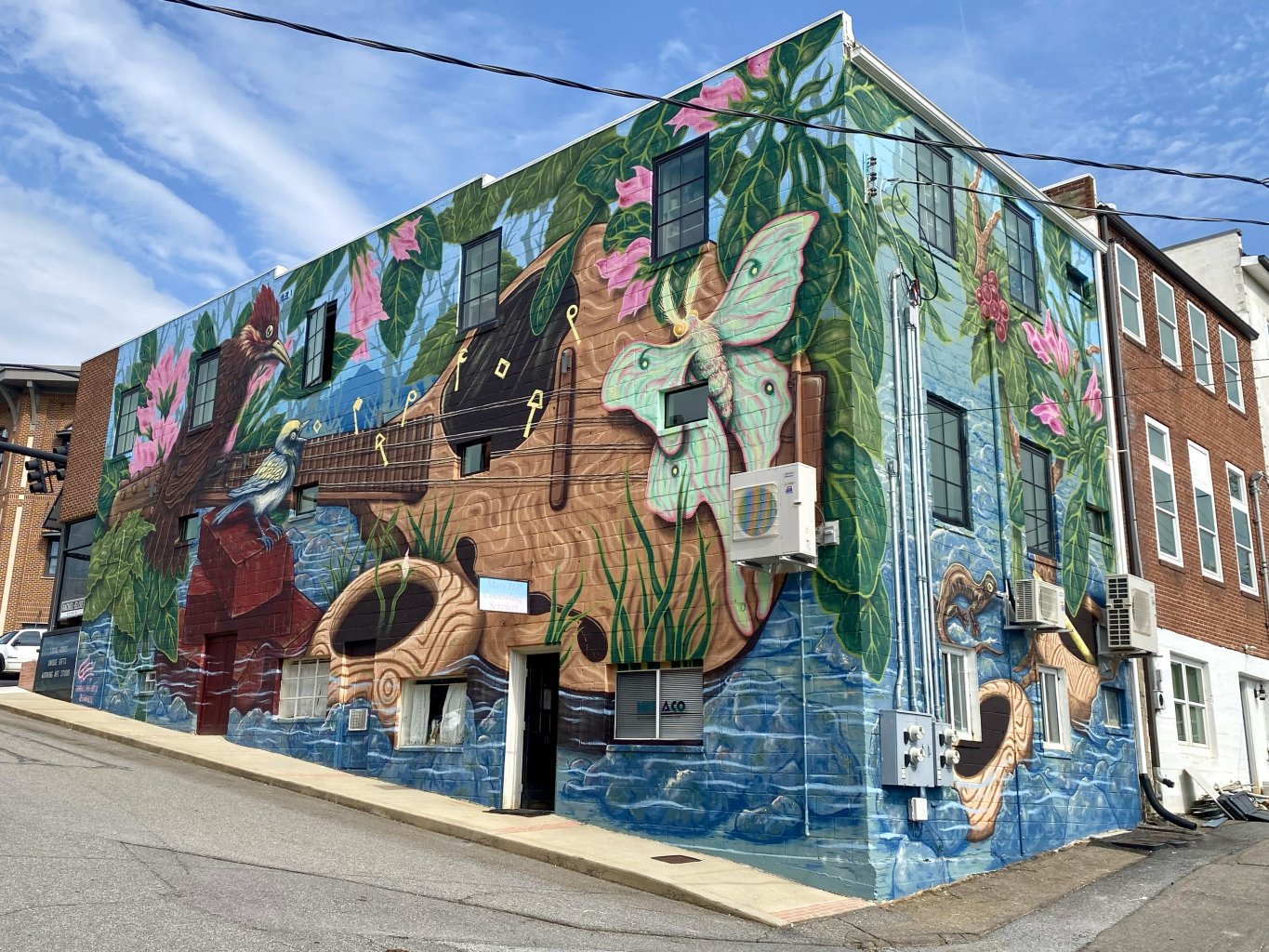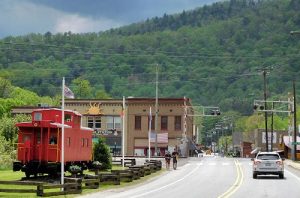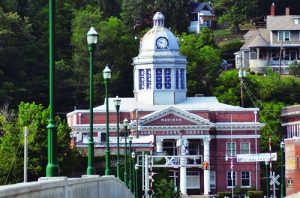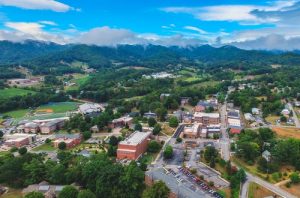Murals in Madison County, North Carolina

The mural was created through a community project facilitated by Kelly Moore Spencer, psychology and art therapy professor at Mars Hill University. To create a mural representing the Town of Mars Hill, a survey was distributed to community members and individuals within the University, garnering over 200 responses full of ideas and suggestions on what to include. Analysis of the data revealed common themes such as Bailey Mountain, local flora and fauna, Appalachian heritage, and specific historical events. Mural artist Gabe Eng-Goetz collaborated with Laura Boggess, an environmental Studies professor at Mars Hill University, and others to incorporate symbols reflecting the themes identified in the survey.
Additionally, six local apprentices, Madison Ammons, Jennifer Hott, Kaitlyn Johnson, Grace Keaser, Carlos Miranda, and Amanda Nicholson, contributed to the painting of the mural.
Bailey Mountain
One of the most prevalent survey responses highlighted the interest in featuring Bailey Mountain on the mural. Situated within walking distance of Mars Hill University, Bailey Mountain Preserve is a 250-acre public preserve acquired through community-driven conservation initiatives (including bake sales and car washes!). The mural showcases species found in the preserve, and the eight miles of trail provide ample opportunities to greet them.
Local Flora and Folklore
Ginseng is a native medicinal plant that many local people harvest from the wild. Mountain lore calls the pileated woodpecker a ‘sang bird’. According to the tale, if someone harvesting ginseng has been in harmony with nature, the bird’s loud call would guide them through the forest to the ginseng patch. The woodpecker would steer them away from the ginseng if the harvester had been disrespectful and out of balance with nature.
Rhododendron blooms grace the mural, a local plant that flowers around the time of Mars Hill University graduation each year, honoring the students’ hard work at the University. Rhododendron, also known as ‘Laurel’ by locals, has influenced the names of many places throughout Madison County.
Local Fauna
The Southeastern United States boasts the world’s greatest salamander biodiversity, and the southern Zig-Zag salamander is a rare species that was found on Bailey Mountain. The identification of the Zig-Zag species in this area helped secure funding to protect the mountain and its streams.
Additionally, the Golden-Winged Warbler, a songbird facing a significant decrease in population, has received attention from local conservation groups and Mars Hill University biology students, who have worked to create habitats for the warbler throughout the region.
Mars Hill History – Legacy of Joseph Anderson
Joe Anderson, an enslaved individual, was used as collateral for the college’s debt to the contractor who completed the first building on campus. He was imprisoned until the debt was paid. Several sources note that Anderson was considered, “the best brick maker in three counties,” and oral tradition says that Joe may have helped make the bricks for the first building. Gabe chose to represent this part of history by making the bricks a prominent piece in the mural.
Education
In 1961, Oralene Anderson Graves Simmons, the great-great-granddaughter of Joseph Anderson, made history as the first African American admitted to Mars Hill College. Since then, her daughter and granddaughter have also become alumnae.
The Anderson Rosenwald School, established in 1929 in the Long Ridge Community, stands as a significant historical landmark, representing the initiative that provided African Americans in Western North Carolina with reliable access to public education.
Additionally, the pencil serves as a symbol of the value placed on education in Mars Hill. The strong connection between the Town of Mars Hill and Mars Hill University is a vital aspect of the town’s identity. It is also worth nothing that MHU is the oldest higher education institution in Western North Carolina that remains at its original location.
Cherokee
Many of the survey respondents recognized the importance of honoring and representing the Cherokee people, who were the earliest known inhabitants of present-day Madison County and whose land was taken from them in 1785. The land where Mars Hill University is located was likely used as a hunting ground, not a settlement. The artist chose to depict this connection through the Cherokee pottery you see on the mural.
Appalachian Music
Community responses identified the importance of showcasing Appalachian heritage in the mural, specifically highlighting music and dance. The artist chose to depict this through the mandolin, centered in the mural. Another suggestion included the addition of shape notes, a traditional form of sacred singing popular in the mountains, which still exists in some communities today. In the mural, you can see these yellow notes being sung by the Golden-Winged Warbler.



